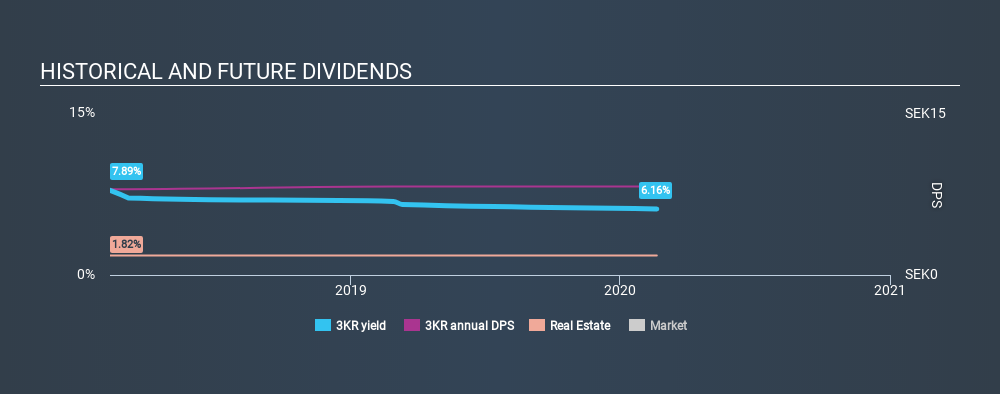
Dividend paying stocks like Tre Kronor Property Investment AB (publ) (STO:3KR) tend to be popular with investors, and for good reason - some research suggests a significant amount of all stock market returns come from reinvested dividends. Yet sometimes, investors buy a stock for its dividend and lose money because the share price falls by more than they earned in dividend payments.
Tre Kronor Property Investment yields a solid 6.2%, although it has only been paying for two years. It's certainly an attractive yield, but readers are likely curious about its staying power. Some simple analysis can reduce the risk of holding Tre Kronor Property Investment for its dividend, and we'll focus on the most important aspects below.
Explore this interactive chart for our latest analysis on Tre Kronor Property Investment!

Payout ratios
Dividends are typically paid from company earnings. If a company pays more in dividends than it earned, then the dividend might become unsustainable - hardly an ideal situation. So we need to form a view on if a company's dividend is sustainable, relative to its net profit after tax. Looking at the data, we can see that 51% of Tre Kronor Property Investment's profits were paid out as dividends in the last 12 months. A payout ratio above 50% generally implies a business is reaching maturity, although it is still possible to reinvest in the business or increase the dividend over time.
In addition to comparing dividends against profits, we should inspect whether the company generated enough cash to pay its dividend. Tre Kronor Property Investment paid out 108% of its free cash last year. Cash flows can be lumpy, but this dividend was not well covered by cash flow. While Tre Kronor Property Investment's dividends were covered by the company's reported profits, free cash flow is somewhat more important, so it's not great to see that the company didn't generate enough cash to pay its dividend. Were it to repeatedly pay dividends that were not well covered by cash flow, this could be a risk to Tre Kronor Property Investment's ability to maintain its dividend.
Consider getting our latest analysis on Tre Kronor Property Investment's financial position here.
Dividend Volatility
Before buying a stock for its income, we want to see if the dividends have been stable in the past, and if the company has a track record of maintaining its dividend. The dividend has not fluctuated much, but with a relatively short payment history, we can't be sure this is sustainable across a full market cycle. During the past two-year period, the first annual payment was kr8.00 in 2018, compared to kr8.25 last year. Dividends per share have grown at approximately 1.6% per year over this time.
It's good to see at least some dividend growth. Yet with a relatively short dividend paying history, we wouldn't want to depend on this dividend too heavily.
Dividend Growth Potential
While dividend payments have been relatively reliable, it would also be nice if earnings per share (EPS) were growing, as this is essential to maintaining the dividend's purchasing power over the long term. Tre Kronor Property Investment's earnings per share have fallen -34% over the past year. This is a pretty serious concern, and it would be worth investigating whether something fundamental in the business has changed - or broken. Any one year of performance can be misleading for a variety of reasons, so we wouldn't like to form any strong conclusions based on these numbers alone.
We'd also point out that Tre Kronor Property Investment issued a meaningful number of new shares in the past year. Trying to grow the dividend when issuing new shares reminds us of the ancient Greek tale of Sisyphus - perpetually pushing a boulder uphill. Companies that consistently issue new shares are often suboptimal from a dividend perspective.
Conclusion
When we look at a dividend stock, we need to form a judgement on whether the dividend will grow, if the company is able to maintain it in a wide range of economic circumstances, and if the dividend payout is sustainable. Tre Kronor Property Investment gets a pass on its dividend payout ratio, but it paid out virtually all of its cash flow as dividends. This may just be a one-off, but we'd keep an eye on this. Second, earnings per share have been in decline, and the dividend history is shorter than we'd like. Using these criteria, Tre Kronor Property Investment looks quite suboptimal from a dividend investment perspective.
You can also discover whether shareholders are aligned with insider interests by checking our visualisation of insider shareholdings and trades in Tre Kronor Property Investment stock.
We have also put together a list of global stocks with a market capitalisation above $1bn and yielding more 3%.
If you spot an error that warrants correction, please contact the editor at editorial-team@simplywallst.com. This article by Simply Wall St is general in nature. It does not constitute a recommendation to buy or sell any stock, and does not take account of your objectives, or your financial situation. Simply Wall St has no position in the stocks mentioned.
We aim to bring you long-term focused research analysis driven by fundamental data. Note that our analysis may not factor in the latest price-sensitive company announcements or qualitative material. Thank you for reading.
Market Insights
Community Narratives



